Martin & Mandy
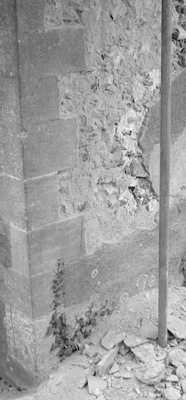 So, Simon the stone mason and his team have been busy and they tend to bring friends to the party - they brought Jon along for starters - Jon knows a thing or two about lime plaster. When I first talked to Jon and asked him about reference sites he said 'Windsor Castle and here's my Royal Warrant' - so our expectations were set pretty high. The North and East wall of the Chancel had plaster and 'stuff' that was either just about to fall off, or so rock hard that it did not move at all. This is what's causing all the damp inside the Chancel, so it was clear that something had to be done. Jon and his chaps turned up to strip back all the loose plasterwork and the core of the problem became immediately obvious. The bottom metre of the plaster is actually concrete which has prevented the walls from 'breathing' over the years, and hence the damp. So a larger drill is deployed and the concrete is removed. Now that might sound easy but it's not - the problem here is if you just attack the stuff then as the concrete pulls away it brings with it all the actual cobble infill and original plaster and that's just what we don't want to do, so that big drill needs to be used with extreme care!
So, Simon the stone mason and his team have been busy and they tend to bring friends to the party - they brought Jon along for starters - Jon knows a thing or two about lime plaster. When I first talked to Jon and asked him about reference sites he said 'Windsor Castle and here's my Royal Warrant' - so our expectations were set pretty high. The North and East wall of the Chancel had plaster and 'stuff' that was either just about to fall off, or so rock hard that it did not move at all. This is what's causing all the damp inside the Chancel, so it was clear that something had to be done. Jon and his chaps turned up to strip back all the loose plasterwork and the core of the problem became immediately obvious. The bottom metre of the plaster is actually concrete which has prevented the walls from 'breathing' over the years, and hence the damp. So a larger drill is deployed and the concrete is removed. Now that might sound easy but it's not - the problem here is if you just attack the stuff then as the concrete pulls away it brings with it all the actual cobble infill and original plaster and that's just what we don't want to do, so that big drill needs to be used with extreme care!
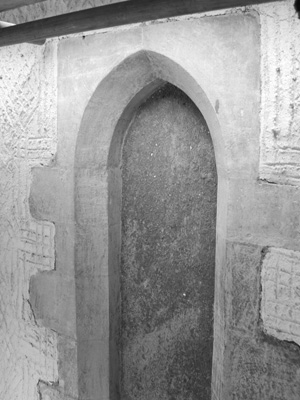 You can see from the picture to the left of the south east of the Chancel that the corner blockwork is just fine, the exposed rubble infill can be seen at the top, then at the bottom all the concrete before it was removed. Next came two layers of coarse lime plaster to bond to the rubble infill, and we are just letting that dry properly before applying the finishing layers.
You can see from the picture to the left of the south east of the Chancel that the corner blockwork is just fine, the exposed rubble infill can be seen at the top, then at the bottom all the concrete before it was removed. Next came two layers of coarse lime plaster to bond to the rubble infill, and we are just letting that dry properly before applying the finishing layers.
In the picture to the right you can see the two layers of coarse plaster but you can also see how the thin concrete layer has been carefully removed from the stonework window surround but left in the blank infill. This is becasue it's just too firmly attached to risk removing it, as it will almost certainly do more damage than good if we try.
We are using these two walls as a test case but, judging by the results so far, it is a bit obvious why he has Royal approval for his work.
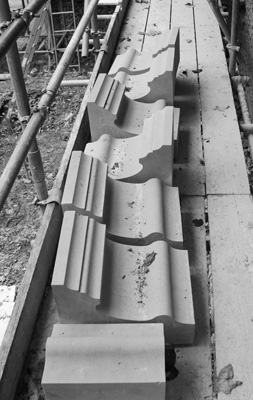 So whilst Jon is tinkering around with Lime Plaster Simon has been been busy manufacturing the outer stonework for the triple windows on the south of the Nave and over the next few weeks these will get replaced.
So whilst Jon is tinkering around with Lime Plaster Simon has been been busy manufacturing the outer stonework for the triple windows on the south of the Nave and over the next few weeks these will get replaced. 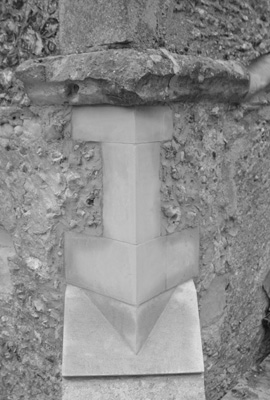 These two windows were the most coroded windows in the whole building and, although we got away with only changing one piece of stone in the entire tower, on these two windows after a lot of consideration, consultation and planning we decided to change all the outer stone work back to the window line.
These two windows were the most coroded windows in the whole building and, although we got away with only changing one piece of stone in the entire tower, on these two windows after a lot of consideration, consultation and planning we decided to change all the outer stone work back to the window line.
The inside stone work will be de-frassed like the tower and then a number of coats of shelter coat applied, which means we will hang onto the look and feel from the inside. We are using these two windows as a dry run for the main event which is what to do with the West window in the Tower.
We managed to remove the corroded feramenta (that's metalwork to you and me) and the frame did not fall to pieces, but it was a close call.
The picture to the right is new jambs on the scaffold for the Nave triple windows ready to be installed.
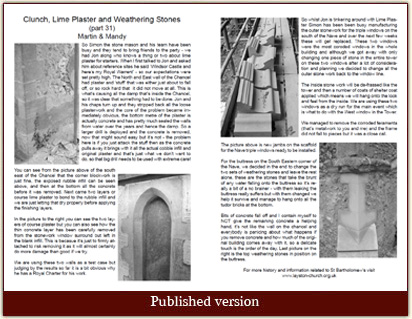 For the buttress on the South Eastern corner of the Nave, we decided in the end to change the two sets of weathering stones and leave the rest alone, these are the stones that take the brunt of any water falling onto the buttress, so it's really a bit of a no brainer - with them leaking the buttress really suffers, but with them changed we help it survive and manage to hang onto all the tudor bricks at the bottom.
For the buttress on the South Eastern corner of the Nave, we decided in the end to change the two sets of weathering stones and leave the rest alone, these are the stones that take the brunt of any water falling onto the buttress, so it's really a bit of a no brainer - with them leaking the buttress really suffers, but with them changed we help it survive and manage to hang onto all the tudor bricks at the bottom.
Bits of concrete fall off and I contain myself to NOT give the remaining concrete a helping hand, it's not like the wall on the chancel and everybody is panicking about what happens if you remove concrete and how much of the original building comes away with it, so a delicate touch is the order of the day. The last picture on the right is the top weathering stones in position on the buttress.
 |
|
 |

